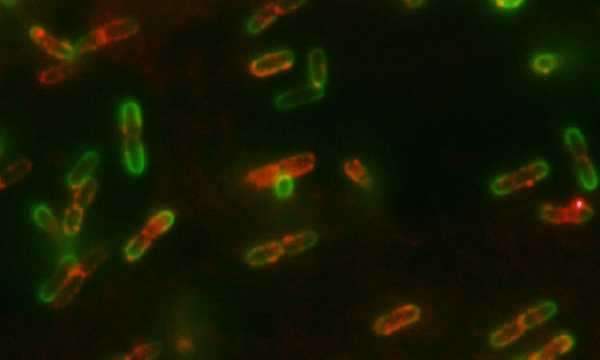
AcrA proteins (red) bind to the outer membranes of E.coli (green).
Swarming bacteria “scream” when they die, warning neighboring bacteria of danger.
These death shrieks aren’t audible; rather, they are chemical alarms that the bacteria broadcast while on the verge of death, an action known as necrosignaling.
Through necrosignaling, bacteria alert their swarming neighbors to the presence of a deadly threat, and thereby save the majority of the swarm (a bacterial colony that’s on the move). When confronted by a threat such as antibiotics, the bacteria’s chemical death cries can provide survivors enough time to acquire mutations that convey antibiotic resistance, scientists reported in a new study.
Many species of bacteria swim about with the help of slender tail-like structures called flagella, which help them swiftly. And sometimes, bacteria such as Escherichia coli (E. coli) congregate in the billions and use their flagella to move together over solid surfaces, as a swarm.
“Bacterial swarms are metabolically active and grow robustly,” almost like a single organism does, the researchers wrote. For that reason, the scientists suspected that swarms could also have their own mechanisms for evolving antibiotic resistance, which could differ from those of individual bacteria.
Researchers previously noted that when swarming bacteria encountered antibiotics, about 25% of the roaming colony died. The dead bacteria seemed to somehow protect the survivors — surviving cells appeared to actively move away from the antibiotics after a portion of the swarm died — but it was unclear what guided the bacteria’s behavior.
In the new study, scientists observed swarms of E. coli bacteria as they interacted with antibiotics, to unravel how dead cells might help save the rest of the swarm.

E. coli can gather in the billions as a swarm, moving together over solid surfaces.
Signals from the dead
that bound to the outer membranes of living cells in the swarm. After the signal was received, the bacteria moved away, which suggested the compound communicated “a state of emergency,” alerting the living bacteria to the presence of danger, according to the study.
But the sacrifice of the dead bacteria didn’t just send a warning; it also activated pumps in the membranes of the live cells “to start pumping out the antibiotics,” study co-author Rasika Harshey, a professor of molecular biosciences at the University of Texas at Austin, told Live Science in an email.
Related Content
– Microbiome: 5 surprising facts about the microbes within us
– 5 ways gut bacteria affect your health
– Beachgoers beware? 5 pathogens that lurk In sand
The cascade of genes turned on by necrosignals not only protected the surviving swarm from antibiotics, but promoted future resistance to the compounds that killed their comrades. What’s more, the scientists realized that subpopulations of swarm bacteria were genetically variable; some were more susceptible to the antibiotics than others. Swarms of bacteria may collectively cultivate different subpopulations as an evolutionary survival strategy — if new antibiotics kill the vulnerable members of the swarm, their deaths will help to protect the rest, the study authors wrote.
“Dead cells are helping the community survive,” Harshey said.
The findings imply that in dense bacteria swarms, exposure to low doses of antibiotics could actually promote the acquisition of antibiotic resistance — an important consideration for research into strategies for defeating bacterial infections, she added.
The findings were published online Aug. 19 in the journal Nature Communications.
Originally published on Live Science.
Sourse: www.livescience.com





